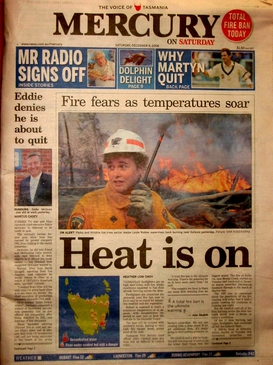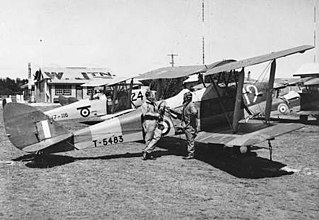Related Research Articles

The de Havilland Express, also known as the de Havilland D.H.86, was a four-engined passenger aircraft manufactured by the de Havilland Aircraft Company between 1934 and 1937.

The Bass Strait Triangle is the waters that separate the states of Victoria and Tasmania, including Bass Strait, in south-eastern Australia. The term Bass Strait Triangle appears to have been first used following the disappearance of Frederick Valentich in 1978 although the region had a bad reputation long before that.
The Cirrus and Hermes or Cirrus-Hermes are a series of British aero engines manufactured, under various changes of ownership, from the 1920s until the 1950s. The engines were all air-cooled, four-cylinder inline types, with earlier ones upright and later designs inverted.
Sunstate Airlines is a subsidiary of Qantas which operates regional flights under the QantasLink banner throughout Queensland, and between Brisbane and Canberra. Its head office is in Mascot, New South Wales, Australia.

Australian National Airways (ANA) was Australia's predominant aerial carrier from the mid-1930s to the early 1950s.

TheMercury is a daily newspaper, published in Hobart, Tasmania, Australia, by Davies Brothers Pty Ltd, a subsidiary of News Corp Australia, itself a subsidiary of News Corp. The weekend issues of the paper are called Mercury on Saturday and Sunday Tasmanian. The current editor of TheMercury is Craig Herbert.

The de Havilland DH.60 Moth is a 1920s British two-seat touring and training aircraft that was developed into a series of aircraft by the de Havilland Aircraft Company.

The DH.83 Fox Moth is a small biplane passenger aircraft from the 1930s powered by a single de Havilland Gipsy Major I inline inverted engine, manufactured by the de Havilland Aircraft Company.

Australian National Airways, Ltd. (ANA) was a short-lived Australian airline, founded on 3 January 1929 by Charles Kingsford Smith and Charles Ulm.

The Avro Avian is a series of British light aircraft designed and built by Avro in the 1920s and 1930s. While the various versions of the Avian were sound aircraft, they were comprehensively outsold by the de Havilland Moth and its descendants.

The de Havilland DH.75 Hawk Moth was a 1920s British four-seat cabin monoplane built by de Havilland at Stag Lane Aerodrome, Edgware.

The Saro A.21 Windhover was a British amphibious aircraft from the period between World War I and World War II, constructed by Saunders-Roe, or Saro. It was originally advertised as the A.19 Thermopylae after the famous clipper ship, being an enlarged version of the Saro Cutty Sark.

Seaplane Squadron was a flying unit of the Royal Australian Air Force (RAAF) between the wars. It operated Supermarine Southampton flying boats from January 1928, as well as other types. Along with Fighter Squadron, Seaplane Squadron was a component of No. 1 Flying Training School, based at RAAF Point Cook, Victoria. Seaplane Squadron was responsible for coastal reconnaissance, training aircrew to operate seaplanes, and supporting the Royal Australian Navy. It also conducted survey flights over remote parts of Australia and mapped the Darwin–Sydney section of the Empire Air Mail Scheme route. Seaplane Squadron was disbanded in June 1939.
National Jet Systems, formerly Cobham Aviation Services Australia - Airline Services, is an Australian regional airline based at Adelaide Airport, operating regular scheduled services as part of the QantasLink brand.
Sharp Airlines is a regional airline founded in Hamilton, Victoria, Australia in 1990. Sharp operates scheduled airline services in the southern states of Australia. Its main bases are Essendon Airport, Adelaide Airport, Launceston Airport and Brisbane Airport. The airline also provides charter operations to Tasmania, Victoria and South Australia. The parent company, Sharp Aviation, has its main maintenance base at Launceston Airport. Sharp Airlines has no registered ICAO code.

No. 7 Elementary Flying Training School was a Royal Australian Air Force (RAAF) pilot training unit that operated during World War II. It was established in August 1940 at Western Junction Aerodrome, Tasmania, and provided introductory flying training to new RAAF pilots. Training activities ceased in December 1944, and the unit was disbanded in August the next year.

Holyman House is an iconic Art Deco building in the central business district of Launceston, Tasmania, Australia.

Queenstown Airport is an aerodrome located at Howard's Plains west of Queenstown, Tasmania, Australia. Formerly a commercial airport, the aerodrome no longer receives regular passenger services, but is maintained by the West Coast Council for a variety of aviation and non-aviation related uses.

Hereward de Havilland was a pioneer British aviator, test pilot and member of the de Havilland company. One of the three sons of Rev. Charles de Havilland, he was the younger brother of Geoffrey de Havilland. Actresses Olivia de Havilland and Joan Fontaine were his cousins. He had a son Peter Adam de Havilland and grandchildren John and Joanna de Havilland.
Hart Aircraft Service Pty. Ltd. was an Australian aviation company registered at Melbourne in mid-1929 with directors James Hart, John Hider and Norman Charles Trescowthick. Director James Hart (c1891-1951) was a former Royal Flying Corp aviator who had flown as gunner for Hereward de Havilland. Norman Trescowthick had served with distinction in the Australian Flying Corps' famous 4th Squadron with Arthur H. Cobby during the First World War.
References
- ↑ The Mercury, 31 December 1926
- ↑ The Mercury , 23 October 1928
- ↑ Brisbane Courier, 19 September 1928, The Mercury, 23 October 1928
- ↑ "Strait Air Service". The Herald. 20 March 1934.
- ↑ The Mercury, 12 January 1935, The Examiner , 1 August 1934, 28 November 1936.